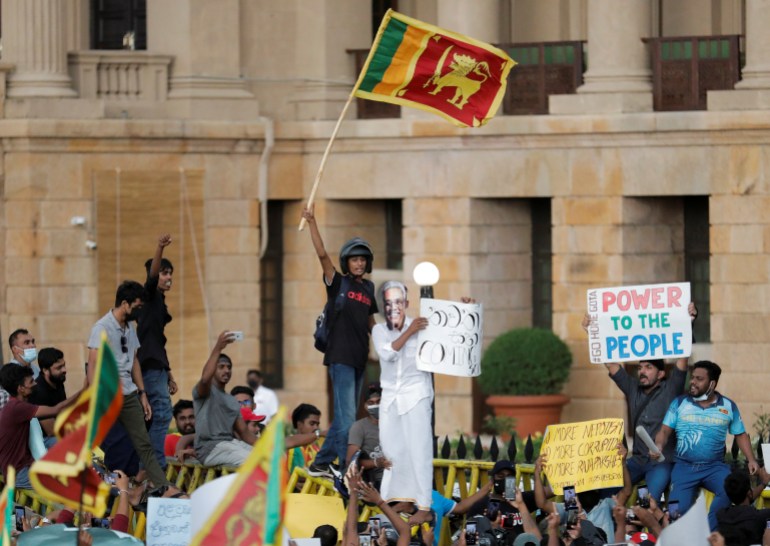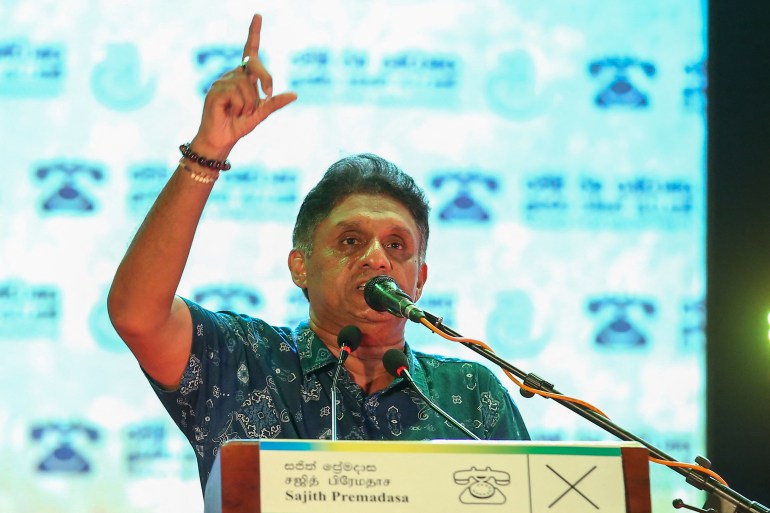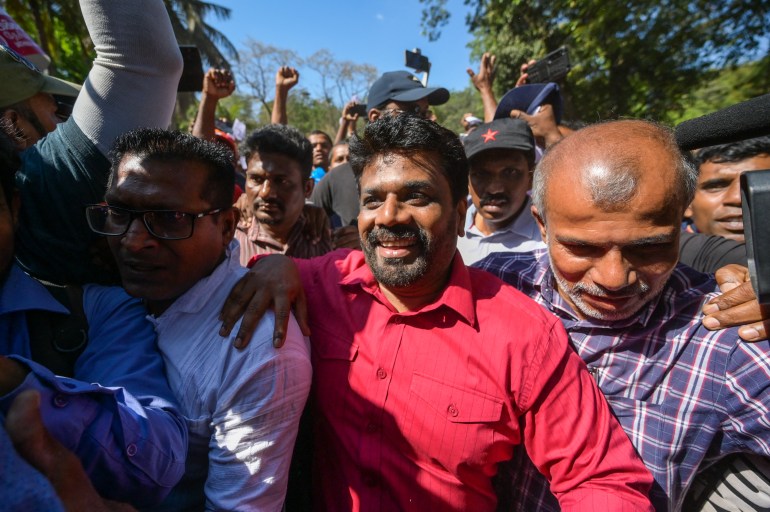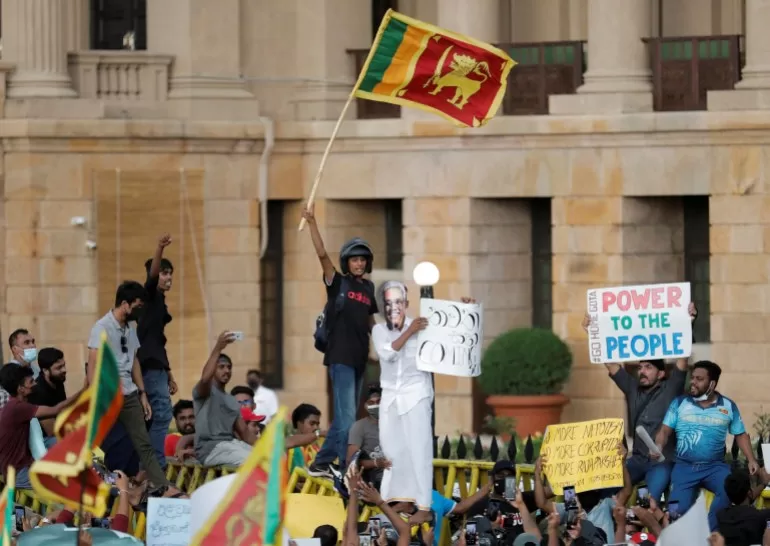Ahead of Sri Lanka’s presidential election, no issue is more central than the economy.
With the South Asian country still struggling from its worst financial crisis in decades, Saturday’s ballot amounts to a referendum on austerity measures imposed by the International Monetary Fund (IMF) last year.
In a crowded field of 38 candidates, all eyes are on three men: incumbent President Ranil Wickremesinghe and his two closest rivals, Anura Kumara Dissanayake and Sajith Premadasa, both of whom want a new deal with the Washington, DC-based lender.
A six-time prime minister, Wickremesinghe represents the old guard.
His United National Party (UNP) has been one of Sri Lanka’s dominant political forces since the country’s independence in 1948.
While Wickremesinghe’s supporters commend his $2.9bn IMF loan – and subsequent debt restructuring deals – Sri Lankans experienced a cost-of-living crisis on his watch, with inflation peaking at nearly 74 percent in 2022.
After the end of its civil war in 2009, Sri Lanka borrowed heavily to fund infrastructure-led growth.
Then, in 2019, President Gotabaya Rajapaksa introduced unfunded tax cuts. Fiscal pressures were compounded when the COVID-19 pandemic led tourism and remittance inflows to dry up.
In 2022, a surge in oil prices and rising US interest rates tipped Sri Lanka into a balance of payments crisis. To maintain imports, Colombo was forced to prop up its plunging currency – the rupee – by running down scarce international reserves.

Rajapaksa’s government faced an increasingly stark choice – continue servicing its international debt or pay for critical imports like food, fuel and medicine. In April 2022, Sri Lanka defaulted on $51bn of external debt.
By July, with the country facing shortages of essential goods and power blackouts, inflation was hovering at 60 percent. Anger over the government’s handling of the crisis led to mass street protests, forcing Rajapaksa to flee the country and resign.
As Rajapaksa’s successor, Wickremesinghe was tasked with reversing Sri Lanka’s economic crisis.
With few options on the table, he turned to the IMF. In March 2023, Colombo agreed to a 48-month emergency loan. As with all IMF deals, it came with strict conditions.
In exchange for funds, Wickremesinghe was forced to remove electricity subsidies and double the rate of value-added tax (VAT).
“Wide-ranging austerity also included a sovereign debt restructuring,” Katrina Ell, director of economic research at Moody’s Analytics, told Al Jazeera.
Refinancing operations typically involve exchanging old debt instruments for new, more affordable ones. Sri Lanka’s foreign and domestic lenders had to accept equivalent losses of 30 percent as part of the IMF agreement.
“All these measures do not offer a quick fix,” Ell said.
Still, “Sri Lanka’s economy has shown meaningful signs of improvement” since 2022, she said.
The rupee has stabilised and inflation has come down sharply from its 2022 peak. The World Bank forecasts the economy to expand 2.2 percent in 2024, following two straight years of negative growth.
On the other hand, real wages remain significantly below pre-crisis levels and the country’s poverty rate has doubled, according to the World Bank.

Presidential contender Premadasa, whose Samagi Jana Balawegaya (SJB) party splintered off from Wickremesinghe’s UNP in 2020, has criticised the IMF deal.
Premadasa has argued that boosting export markets and strengthening the rule of law are the way forward.
Yet he is not the main candidate for change, according to Jayati Ghosh, a professor of economics at the University of Massachusetts Amherst.
“That mantle falls to Anura,” Ghosh told Al Jazeera.
Dissanayake’s political stock has risen dramatically in recent months.
Though his far-left Janatha Vimukthi Peramuna (JVP) secured just three seats in the last parliament, it has since re-branded itself to project a more mainstream image.
Today, the JVP represents a coalition of leftist groups. And while it receives strong support from young voters, those over 50 still recall the JVP’s attempts at insurrection in the late 1980s – a period of terror in southern Sri Lanka that led to between 60,000 and 100,000 deaths.
“Dissanayake has distanced himself from his party’s past and his old Marxist leanings,” Ghosh said. “And though he’s inched towards the centre, he’s still the progressive in the race.”
Dissanayake has pledged to increase Sri Lanka’s income tax-free threshold and exempt some health and food items from the 18 percent value-added tax to make them more affordable.
“Anura wants to change the Fund’s insistence on treating external and domestic debt equally,” Ghosh said.
“On top of regressive VAT increases, public pension funds bore a big brunt of the restructuring. Teachers and nurses had their pensions slashed. It’s criminal,” she added.
“Dissanayake would try and push the IMF to shift the burden away from ordinary Sri Lankans onto external creditors. Poor people’s livelihoods have already been badly hit. He has been far more critical on the debt issue than Premadasa.”
Following a $4.2bn debt restructuring with China’s Ex-Im Bank in October, Sri Lanka completed a $5.8bn restructuring with a number of countries including India and Japan in June.
In a last-minute agreement before the election, the country on Thursday clinched a deal with private investors to restructure $12.5bn of international bonds, clearing the way for the release of its fourth tranche of IMF bailout funds.

But, according to Ahilan Kadirgamar, a Sri Lankan economist, “it’s far too favourable to the creditors”.
“In theory, restructuring operations are meant to lower debt costs and free up public resources for things like education and healthcare. That’s not what’s happening in Sri Lanka,” Kadirgamar told Al Jazeera.
Sri Lanka’s debt-to-GDP (gross domestic product) ratio is expected to fall from 128 percent of GDP in 2022 to just above 100 percent by 2028, according to IMF forecasts. Debt servicing costs – the percentage of tax revenues needed to pay creditors – will also remain elevated.
“Recent financing deals were linked to the IMF’s 2023 debt sustainability analysis, which was flawed,” Kadirgamar said. “It didn’t provide enough debt relief, and it requires debt to be paid down through high budget surpluses, meaning less spending on public services.”
Sri Lanka’s fiscal balance went from a deficit of 3.7 percent of GDP in 2022 to a surplus of 0.6 percent in 2023.
“In part, that came from less spending on infrastructure projects … which may well result in lower growth, making future debt dynamics worse,” Kadirgamar said.
Sri Lanka’s fiscal position is also hindered by a low tax base.
According to the World Bank, tax revenue collection as a share of GDP is typically in the range of 15-20 percent in low and middle-income countries. In Sri Lanka, it is about 8 percent – among the lowest in the world.
Kadirgamar said that “years of liberal free-market policies” and the “disastrous 2019 budget” had undermined fiscal stability.
“Whoever wins the election should focus on overhauling the IMF deal and introducing a wealth tax,” he said.
Kadirgamar said the country also continues to be too dependent on imports.
“I think we should build out industries linked to Sri Lanka’s natural resources,” he said, pointing to the country’s “enormous oceanic resources” including seafood and off-shore wind.
Elsewhere, investing in Sri Lanka’s coconut and dairy industries could “expand the rural tax net and reduce foreign exchange constraints”, Kadirgamar said.
“Sri Lanka’s recovery is still fragile. Trying to alter the terms of the IMF package may cause short-term pain,” he added.
“But on the current trajectory, I fear Sri Lanka will enter repeated defaults in the future. It’s time to get our house in order.”
